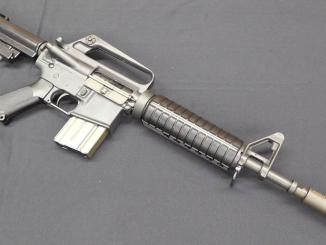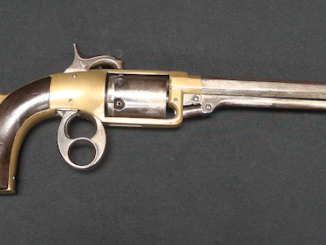Lot 1451 in the September 2019 RIA auction.
Made by the Cummings Gun Works of Boston late in World War One, this is a pseudo-firearm training device for teaching some aspects of marksmanship without the safety hazard of bullets actually flying around. This one appears to be intended to teach shooters to hold the rifle perfectly vertical. Equally interesting to me is the use of unfinished Mosin Nagant components, almost certainly procured from Remington when its Mosin Nagant contract was interrupted by the Russian Revolution.




Wow used something almost like it in scouts 50 some odd years ago. Loaded it with a .22 blank like fir a starter pistol and when it “shit” it would mark exactly in the paper where you’d hit. You loaded it with miniature targets and aimed at a real one.
Didn’t the contract Remington Mosin’s have the standard “dog lease” sling arrangement? Probably had to source the sling swivels else where.
Holding your weapon at anything but vertical renders your sights useless for all targets except those within baseball pitching distance. I assume we’re not within that range during most skirmishes…
The ‘Dot’ Needle would float freely in all planes as the rifle was aimed at a distant target. The ‘holder’ on this device was loaded with a cardboard “Sub-Target”.
The device was adjusted so the “Sub-Target” and distant target with a proper sight-picture were aligned. When ‘Fired’ the needle would mark the “Sub-Target”, giving a representation of where the sights were aiming and a shot would strike at the time of ‘Firing’.
This approach was a much cheaper device than the $500 to $600 “Cummings Sub-Target Gun Machine”,(also, manufactured by Wilkinson, under license), that was purchased for U.S. and British Military Academies, Royal Navy Ships and bases, Military Schools around the World, and New York Public Schools.
I wonder if the stuff on top allows the instructor to look over the Student’s shoulder and correct him.
These look to be the patent drawings:
https://patents.google.com/patent/US1323841
From the first drawing, it is evident that the rifle was supposed to be on a flexible mount relative to a distant target, and the gizmo measured how far off the sights were from that target. I think the needle indicator would have recorded how close it was to the target, not just if the rifle was canted or not.
This patent matches the date on the rifle:
https://patents.google.com/patent/US739778
Although the “Cummings Dot Rifle” in the video has the September 22, 1903 patent date marking of US739778A, that patent is for an entirely different device, the “Sub-Target Gun Machine” which is the pedestal connected monstrosity which used a needle to punch a target mounted on the pedestal, with the rifle connected by cantilever type mounts and a mechanical linkage to trip the needle on some, or an electrical solenoid on others. The Subtarget Machine used a regular rifle permanently altered for use with the machine. These were pretty widely used by U.S. Army, Navy and National Guard units, and also youth shooting programs (including New York City public schools!). Many British Commonwealth countries also used the, and depending on the user, they may have had Krags, M1903 Springfields, assorted Lee Enfields, or Mausers.
HAS ANYONE EVER SEEN A GOOD PHOTO OF THE SUBTARGET MACHINE? Have any of the machines survived anywhere in the world? There are some crappy old photos in Brophy books or the UK Rifleman site, but I really would like to see a good photo.
The device in the video is based on Cummings’ US1323841A dated December 2, 1919.
He also invented a dotter type contraption for use on Navy ship guns mounts. Also numerous non-firearm mechanical devices.
One of the silliest things is, that like the later Swift Training Rifles, this particular analog simulator was decried as a “sissy gun” by conservative detractors, who insisted on training even the freshest of suburban recruits with “full strength PUNCHING power” as to “make men from boys” and “turn wimpy pen-pushers into all-out macho war-winners.” Any rookie soldier who shied away from the real rifle (or literally tossed the thing away after firing it exactly once) for fear of the recoil and noise would be given quite a few lashes for insubordination… I hope this never happened.
The inventor filed a lot of patents for mechanical devices, including a sewing machine, a new kind of rivet, etc. He filed a few other gun related patents as well: a self oiling rifle, and a rotary magazine.
He had a company, Cummings Machine Works, in Boston: https://en.wikipedia.org/wiki/Cummings_Machine_Works That company, whether invented by himself or someone else, had patents on everything from hydraulic hospital beds to automatic doughnut machines.
Suspect that Cummings Gun Works was a stand alone company he put together during WWI.
It’s great to be here with everyone, I have a lot of knowledge from what you share, to say thanks, the information and knowledge here helps me a lot.
I love that stamped brass name badge !